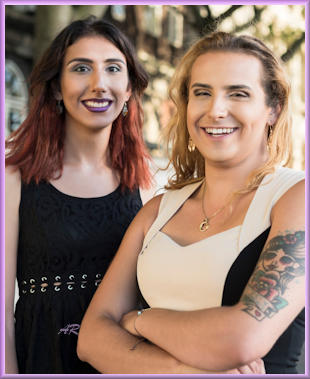|
 For a male-to-female
transsexual (MTF) - transitioning is the period when you stop living
your every-day life as man and begin living it as a woman. It
sounds short and easy - what more can be said? Actually, alot of girls have a lot to say, for example,
Calpernia Addams: For a male-to-female
transsexual (MTF) - transitioning is the period when you stop living
your every-day life as man and begin living it as a woman. It
sounds short and easy - what more can be said? Actually, alot of girls have a lot to say, for example,
Calpernia Addams:

"I did feel like
I went through puberty at age 24. Learning to wear a bra, makeup,
date boys, all that - everything other girls learn at age 13. And
we're alone. Most of the time society hates us - people think
we're freaks or whatever - so you're doing all this alone. And it
can be really hard."
For the vast majority of MTF's, transitioning is in fact an enormous
challenge, and probably the most stressful time of their life. The
former professional cyclist Robert Millar - a married man with a son -
is an example of the real-world problems that transitioners face.
Friends became suspicious when the then 40-year old was seen with his
hair in pigtails
and a suggestion of breasts under his top. One said, "Every time
we meet him he seems to have a bigger chest, but he won't talk about
it". Two years later he - now she - moved away and changed
her name to Phillippa York, sadly leaving her friends, family and son behind.

Daria Jane records on social media
(in particular her YouTube
account) her journey
from a
teenage boy to a young woman. Whilst
taking female hormones contributed significantly towards her
much changed physical appearance, she
also had major and expensive feminisation surgery. [Romania]

A still from a Norwegian TV documentary following a transitioning young transwoman, showing her being chatted up
by young men. |
However, a successful transition -
even without "bottom surgery" - is a huge toward step towards mental
health as gender starts to align and match with lifestyle, physical
appearance. and sexual relations. The term "Gender Euphoria" is
sometimes used to describe a successfully transitioned women who delights
in her new ability to wear women clothes, use makeup, have
fancy nails, go pink, grow her hair, have a bling phone case, etc.
One newly transitioned transwoman (me) spent 40 minutes at a
music festival queuing to use the female toilets whilst the men's were
queue free - despite her increasing desperation to pee she recollects
considering these were the best minutes of her life so far.

Physical feminisation is essential for passing post transition.
This diagram shows with reasonably accuracy the likely changes
(not all positive) resulting from hormone therapy and
surgery.
Genital tucking is often used by drag artists and transvestites -
the testicles are gently pushed up into the inguinal canal, whilst
the scrotum and penis are then pulled backward and secured between
the buttocks using tape. Whilst the resulting bottom appearance
is excellent even in a bikini, but it is not really suited for use by
transitioned transwomen as prolonged daily tucking soon results in chafing,
skin irritation, and testicular discomfort and pain. Long term,
there is a serious complications such as epididymitis and
orchitis. In practice the effects of estrogen on male genitals
soon negates the need to tuck. |

Ally Rose is an example of how modern medical
support can help a 20-something transition successfully:
(Top left) Pre-everything and posting as a "cross-dresser"
(Top middle) After starting hormones and having breast augmentation
(Top right) After facial feminisation surgery and transitioning in 2015
(Bottom)
After SRS, now working as a female model
She married her boyfriend in
2019.
|
|

Emel Aydan, was born
in 1951 as Erdoğan Kaşif. 'Emel' translates
roughly to 'Desire' in English. She
chose this when transitioning to help her career as a
singer, showgirl and actress. |
A New Name One of the biggest
considerations when transitioning is selecting a new name. This
will be 'set in stone' as you start introducing yourself with it; ask
embarrassed friends and family to call you this; change bank details and
documents; and submit it to government bodies.
Two widely differing
approaches are common:
-
Make it easy for family and acquaintances by selecting a feminised
version of your commonly used name, e.g., Jack to Jackie, Charlie
to Charlotte, Terry to Terri, George to Georgina, Bob to Bobbie, ...
or
-
Emphasise your new female identity by selecting a common female name
that has no relationship to your previous Christian name e.g. Liam
to Emma, William to Ava, James to Sophia, Simon to Anne, ...
The first approach helps
avoid the embarrassing situation of someone calling you by your new name but
you not reacting. A very possible scenario after a few glasses of
wine late at night in the first few weeks after transition! Also,
retaining the same initials can help in the re-use of old documents, and
it's credible to suggest that minor differences such as Tony vs Toni are
just a typo error.

Alex identified as a homosexual
man but took oestrogen hormones for many years. She eventually
decided to
transition and had surgery to become a heterosexual woman. |
The second approach has
the additional advantage that it aids stealth. For example, someone searching
for you on Google using the name is unlikely to get relevant hits.
A third option
is to adopt an unusual
or exotic
name that you like, e.g. Caoimhe, Eibhleann, Naimh, Orlaith,
... But the
challenge then is getting people to remember how to spell and pronounce it!

When Keela became involved
in a legal dispute, she was out'ed as born male and pre-SRS.
Documents such as her female driving licence then became
problematic as she had submitted false information to obtain
these. |
Documents A high priority task in every transwoman's transition is changing as
much documentation and as many records as possible to reflect your new name and
sex/gender - and as quickly as possible. But be careful, if your documentation states that you are
female then a female appearance helps a lot - whatever the law says.
For example, a
transitioning transwoman changed her bank
account to her new female identity but when she subsequently visited a branch to make a
transaction the staff suspected that she was a man impersonating the
account holder and blocked all access to her bank accounts. It
took weeks to resolve the issue.
I

Ukrainian singer Zi FaŠmelu transitioned
in 2014 and in 2016
tried to update her official documentation from Male to Female
but failed as she hadn't yet had GCS. When Russia invaded Ukraine in February 2022, she faced military
conscription as a man, and made an epic journey to
Germany. (Left) Zi's
passport, (Right) In Germany, March 2022. |
've included in
a separate page here some information
(mostly derived and updated from Adele's original and now off-line work)
about how to change your name and documentation during the transition in
the UK and Ireland. However much of the information is became out
of date in 2004 with passing of the Gender Recognition Act.
This established a Gender Recognition Panel which makes it immensely
easier to get documents changed and re-issued to reflect a legally
adopted female name and a change of sex, also the level of evidence and
representation required has become less onerous and pre-SRS women are
also often accepted. Basically it involves completing an on-line
form, paying a £5 application fee, and posting a certified copy of your
birth certificate to the Panel. In the vast majority of cases you
will receive
a gender recognition certificate within a month and are now legally
female.
It
is then possible get a re-issued 'female' birth certificate, which in turn
allows changing your passport to "F", including as
flattering a photo as you can get away with! Armed with all these
documents is it's almost any other documents and
records can be changed.

The transition of Alexander Chumakov to Katerina Myers in 2020
caused considerable debate in Russian media and social media
sites. He/she was at the time a Captain in the Russian
Federal Security Service (FSB).
|
If for some reason a
document cannot be re-issued, it is now relatively easy to obtain or
even produce for yourself a very authentic looking "corrected" version -
and this is a risk some transwomen choose to take. However, the
same march of technology also means that increasingly official records
and archives (including Births, Deaths and Marriages) are readily
available on both government computer systems and the internet, and even
the most convincing "original" document may be only a few keystrokes
away from suddenly becoming suspicious. Embedded digital
signatures are also now used to prevent the manipulation of documents
issued in an electronic format.
If you don't pass convincingly as
a woman then the likelihood is that responsible staff/officials will
check out even the most authentic looking documents that state that you
are Female. If there has been misrepresentation or forgery, this
could lead to possible criminal charges.
Exceptions: There
still some important documents that realistically are impossible
to change. For example,
whilst making wedding arrangements at a church, the priest checked our
documents. I mysteriously couldn't find my Baptism Certificate and
promised to bring it to our next meeting. Thankfully he didn't
pursue this as the certificate had the wrong
forenames and there was no way I could have got it changed without
forgery.

Taylor, now Samantha, documented on
social media her journey over the two years
before and after her
transition in 2018, and the resulting evolution of her marriage.
|
Pre-Transition Tips
When choosing your female name, try to keep your initials and
surname the same - "Breda Jane Smith" is a much better
name for a "Brian John Smith" to adopt than "Emma
Dianne
Monroe" would be. If you expect to eventually transition,
avoid whenever possible using the prefix "Mr" or full forenames
on documents, e.g. have "B J Smith" on your store card rather than
"Mr Brian Smith". Avoid using a forename in your
signature, so the credit card of "B J Smith" can then be used by
either Brian or Breda. If you must provide a photo with
an application, use the most androgynous picture of yourself
that you can find, ideally as unfocused (difficult with modern
cameras!) as the issuer will let you get away with.
 Before transitioning, start collecting
documents in your new female name that help "prove" you are female.
These can be anything - travel passes, library cards, membership
cards, store cards, but the more official looking the better.
As your female appearance improves, also start to consider
submitting an en-femme photo to make it more useful as ID. Before transitioning, start collecting
documents in your new female name that help "prove" you are female.
These can be anything - travel passes, library cards, membership
cards, store cards, but the more official looking the better.
As your female appearance improves, also start to consider
submitting an en-femme photo to make it more useful as ID.
It's become impossible in the EU and UK to open a new bank account
or avail of any financial services (loans, investments, pension)
without supporting documents such as a utility bill and passport. It
is thus essential to
build-up a financial background and credit history in the years
before you transition.
By far the easiest way
of doing this is by starting to use your selected female name as that
of a fictional 'female' partner.
Then change over a utility bill into your new fictional female
partner's name. This can often be done by updating your
online account profile, or at worse via a phone call. The
revised bill will become an important
proof of identify and residence as you kill off your old male
identity and "go solo" with your new name after transition.
Secondly, most banks will issue a credit card on your account to a partner at
the same address - in this instance use your female title
(prefix) and prenom (first name), e.g. "Mrs Breda Smith" . This
will also become another
very useful form of emergency ID.
Thirdly, it
may be possible to change
an existing bank account to a joint account with a "female partner" based
upon just a completed form with both your signatures.
Finally, it
may be possible to move
an existing bank account in to a new account name. I had
no problem doing this in 2001, but when I tried in 2018
to regain access to a long dormant account with a small
balance, the level of proof
that I was asked to provide was far too high and costly to justify the effort.
|

There are now so many transgender women in the USA
(an estimated 1.4 million in 2022, 27% of whom are under age 25) that the lingerie industry has begun
catering for them, e.g. sexy tight panties and extra large training bras.
Shown above, from the left, are offerings by Harmonica, Sophie Hines, PACT and AnaOno.

Passing in a carefully selected photo does not equate to real life.
|
Beginning to Pass as A Woman


A few lucky boys pass as a girl
before they transition. |
For
most MTF women an ability to pass consistently as a woman is essential
if they are to enjoy a successful and happy post-transition (and
post-SRS) life, with little or no regrets about their actions.
Sadly, the brutal reality is that less than half
of transitioning transwomen can pass, although since 2010 a huge
surge in the number of teenage transgirls transitioning has
significantly improved the percentage.
IMHO, if a year after
transitioning you are still constantly getting strange stares when
shopping, and your "friends" and even family obviously don't like going
out in public with you, a very hard re-assessment is appropriate before
proceeding further and undergoing irreversible actions such as surgery.
The often lambasted one-year real life test prior to SRS does have a
very serious purpose.

Jamie-Michelle
transitioned age 19. Despite unflattering clothes and
the padded bra, she's still
passable due to her young age. |
 The challenges involved with transitioning are immense, just one
small example is that girls practice their make-up from as young as
age 2. By age 16, most girls will have spent thousands of hours
on doing their make-up, whilst a male-to-female transsexual transitioning as an adult will have only spent a tiny fraction of that time. This
presents an immense challenge, although most transwomen will have vastly
improved the standard of their make-up a year after transition. The challenges involved with transitioning are immense, just one
small example is that girls practice their make-up from as young as
age 2. By age 16, most girls will have spent thousands of hours
on doing their make-up, whilst a male-to-female transsexual transitioning as an adult will have only spent a tiny fraction of that time. This
presents an immense challenge, although most transwomen will have vastly
improved the standard of their make-up a year after transition.
But the good news is that
you can stack the odds in your favour. Just fifty years ago only a
small percentage of adult men could in truth live and pass
convincingly as a woman; nowadays a transitioning MTF transsexual woman
can improve her percentages considerably. Some physical
characteristics (height, hands, feet, ...) remain almost impossible to
change, but the modern transsexual woman has an enormous battery of
weapons that allow her to feminise many of her other characteristics.
For example, good quality silicone breast forms and mastectomy bras are
available for as little as £200 ($300) which bestow on a clothed
transwoman breasts whose appearance and movement are
indistinguishable from a natal woman.

The tall man greatly helps the passability of
these
two transwomen. |
In general, my own advice
is if that you can afford them and need them, then use them:- hormones,
breast augmentation surgery, a 'nose job', facial
feminisation surgery, hair transplants, electrolysis, skin peels,
fat transfer, etc. But a very serious proviso is to always
seek good quality professional medical advice, care and treatment - you
get what you pay for and skimping is a big mistake. To the
physical changes you can add valuable aids such as voice
training, makeup coaching, deportment lessons, grooming tuition... even
cookery lessons (really, mine were a great laugh!).
Assuming that
physically you are reasonably feminine in appearance, then passing
then often becomes all about the small things - things that are
second nature for someone brought up as girl but entirely strange
for a man - and things that Hollywood often has a field day over
when a man impersonates a woman in a comedy.
For
example, I physically
have too many "male" characteristics for comfort - too tall,
big feet, voice. But as an example of how small the
margin between passing and not passing is - when my sister had rhinoplasty
to reduce the size of her "family" nose I decided on impulse to join her
for the same procedure. The change was minimal but afterwards I was astonished at
how many people now assumed that I was a woman - and this was years
before I transitioned.

Sammy Crawford posted these passport photos of her before, during and after
transition.

Unfortunately learning how
to pass
is far less fun than this picture of three transwomen might indicate. |
In Between Two Stools
My second puberty - the period from when I first took hormones in
1994 (age 29) until I started to live full time as
a woman at the end of 2000 - became ever more difficult. Working as a "man"
I knew that my appearance was increasingly odd.
Examples of just
some of the many problems I faced pre-transition when a man included:
- How long could
I grow my hair
-
Realising my eyebrows were too heavily plucked
- Wearing shorts with shaved legs
- Half jokes about my "man boobs"
|

Many transwomen are married or in
serious relation with a cis-woman when they decide to
transition. At the very least there is shock and
confusion, and occassionally the relationship survives the
dramatic change, with the woman sticking with her [former]
man. |
- The reaction to having my ears pierced
- Unexpectedly gaining a girlfriend when about
to transition
When I risked went out in public as a woman, I also faced serious problems and risks
from:
-
My voice
-
Visible facial
hair or a shaving rash
- Using female
toilets
-
Passing a security
check in the female queue
- A child deciding that I was man!

Learn Quickly
An adult (over 18) man trying to "pass" as a woman faces a constant and often high-risk
challenge and obstacle course. It is one thing to dream about
being a woman, to actually try to live as a woman is quite another. It's a
"chicken or the egg" situation - you can't successfully pass as a
woman until you've lived as a woman for many months, but you can't
successfully live as a woman until you can pass as a woman!

Make-up presents an immense challenge to inexperienced
transwoman. Padding your bra was also a big challenge before the advent of
affordable silicone inserts and
breast prostheses. |
Before
I transitioned I always worked as a man, however I increasingly socialised as a woman.
When going to a bar or night club I was constantly stressed as to whether
I was passing. An attempted
chat-up by a man was both a score and a nightmare. For example,
one night I was approached by a handsome and
personable young man who eventually asked me to be his partner for a
'Ladies Night' ball at the local naval base - I just couldn't
bring myself to say "No". But there was no
possibility that I could pass for the whole evening under bright
lights whilst making conversation to other ladies. I increasingly panicked and 20
minutes before he was due to pick me up I called him to say "I'm sorry, but my
boyfriend won't let me come". I still feel awful about letting him down.

When
I first transitioned full-time, every time I appeared in public or had to interact with someone, I
felt that I
was acting a female role. It was brutal going to work as a woman
when I knew that I was not passing and regularly overheard cutting
comments.
However,
when under pressure the human being is an amazingly
quick learner. As the months passed my instincts
and responses become 'female' and panic moments ever rarer.
Helped by hormones and facial electrolysis, I eventually passed
through some kind of magical door and suddenly realised that
strangers were no longer soon outing me as a man, but accepting me
as a woman.
Also,
post transition,
I found that it was much easier for people who had only met me as
"Annie" to accept me as a woman, even if they knew that I was a
transgender, than people who previously known me as a man. When I came out to my family it was obvious that while trying to be
supportive they had problems adjusting, although the passage of time
helped a lot and my mother was always generally supportive.

Elizabeth, born Lee,
became a minor celebrity in the early/mid-2000's after her
transition and dramatic change in appearance due to hormones and extensive
feminisation surgery. A 2005
documentary in which she featured was posted on YouTube.
Surgery

AŽla Chane after her transition. |
Very few transitioning transwomen don't have some surgery.
By a large margin the first surgery sought by all transsexual women is
breast augmentation - requests varying from slight augmentation
in order to reach a natural looking B cup, to porn star G cup balloons.
Facial feminisation
surgery (FFS) is often the next priority. Prior to
about 1995 this really just meant a nose job (rhinoplasty), but
progress since then has been extraordinary. For transwomen
with deep pockets, and willing to stand the pain, an acceptably
female - even attractive - face is often only a large cheque
away. When you are trying to pass in public as a woman
every day, a cute nose and feminine jaw line matters far than
the contents of your panties.
Sex reassignment surgery (SRS) or Gender
Confirmation Surgery (GCS) is sometimes, albeit surprisingly, a
low priority. Reasons for this include:
-
The financial gains from prostitution as a shemale
-
The cost and medical risks associated with the surgery
-
Still enjoying an active sex life with a penis
-
Her partner is firmly against the procedure
-
Sexual libido is so low that she has no interest in having
intercourse as a woman

Elle Bradford was born a boy (probably Jesse) in the USA in April
1992. She started taking hormones and transitioned as Elle age 15
and became one of the first "influencers" on social media due to her fantastic fashion style and dress sense. Her
ability to pass benefited from a slight stature (just 5ft 3in, 160 cm tall)
and small feet (size 6 UK). By 2017, age 25, she had also had
facial feminisation surgery,
breast augmentation and gender confirmation
surgery. She then suddenly went off-line and stealth. |
|

